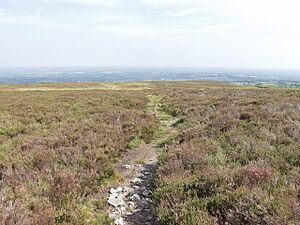Esclusham Mountain facts for kids
Esclusham Mountain (in Welsh, Mynydd Esclus or Mynydd Esclys) is a special area in Wrexham county, United Kingdom. It's part of the Ruabon Moors, a large area of hills. The mountain reaches a height of 460 meters (about 1,509 feet). A nearby peak called Cyrn-y-Brain is a bit taller, at 473 meters (about 1,550 feet). Most of Esclusham Mountain is within the community of Esclusham. A smaller part to the north is known as Minera Mountain and is in the nearby community of Minera.
Contents
Exploring Esclusham Mountain's Geology
Underneath Esclusham Mountain, you'll find ancient rocks. These include Carboniferous Limestone and a type of rock called Millstone Grit. This area was once very rich in valuable minerals. You could find lots of lead and zinc here.
A long crack in the earth, called the South Minera Vein, ran through the mountain. This crack was filled with minerals. Because of this, many lead mines operated here until the early 1900s. Some of these mines even connected to the natural caves deep inside the mountain.
Amazing Caves Underground
The area is home to some incredible caves. The 8-kilometer long Minera Caves, including Ogof Llyn Parc and Ogof Cefn-y-Gist, have entrances right on the moor. Other caves like Ogof Dydd Byraf and Ogof Llyn Du are close by. Their entrances are found in the Minera Limeworks.
These caves are so important that they are protected as Sites of Special Scientific Interest (SSSIs). This means they are special places for nature and science. There are plans to develop them so people can visit and learn about them.
A Look Back at History
People have lived and used Esclusham Mountain for a very long time. There are signs that farmers from the Neolithic (New Stone Age) and Bronze Age lived here. You can still see stone cairns, which are piles of stones left by early inhabitants.
The high ground was perfect for grazing animals in the summer. In the Middle Ages, people built hafodydd (summer houses) here. These were used by shepherds who looked after their flocks.
Mining for Minerals
While some small-scale lead mining might have happened earlier, serious mining began in the 1700s and 1800s. New mining methods from Cornwall helped the industry grow. In the 1800s, a clever engineer named John Taylor helped develop the mines even more. At their best, these mines were the most productive lead mines in all of Britain!
Landscape and Wildlife of Esclusham Mountain
The lower parts of the mountain, especially on the eastern side, are covered with green fields, small farms, and woods. As you go higher, you reach the open moorland, known as the Fron-dêg Flat. This area has plants typical of moorland, like heather, bilberry, and sedge. A rarer plant, the dark red helleborine, also grows here.
Farmers still raise sheep on the moor. You can also see reminders of the old lead mines. There are foundations of old engine-houses, managers' homes, and chimneys in places like Pool Park and Gwter Siani.
Animals of the Moor
The moorland is home to many different animals. You might spot birds like the black grouse, red grouse, and the short-eared owl. The ring ouzel, a type of thrush, also lives here.
A single-track road crosses the northern part of the mountain. It goes from Minera, through Pool Park and Gwter Siani, to Eglwyseg, and then towards Llangollen. Many footpaths are popular with walkers, including the famous Offa's Dyke Path.


